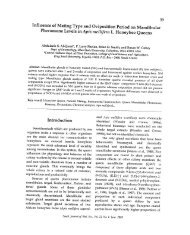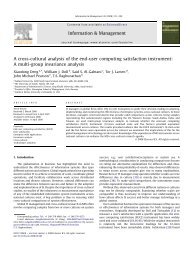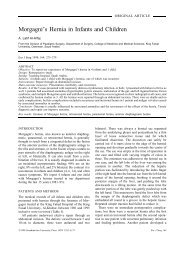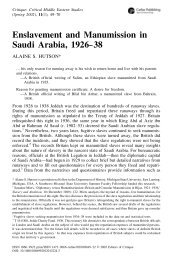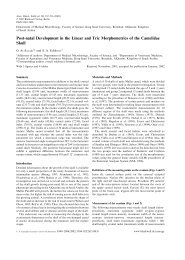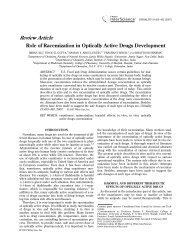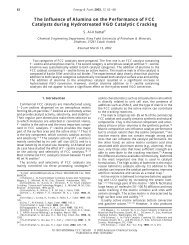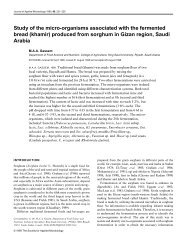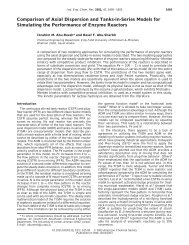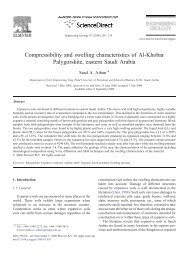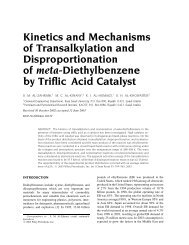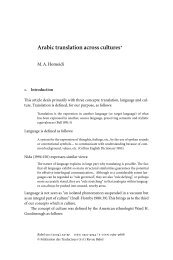The dairy industry in Saudi Arabia: current situation and future ...
The dairy industry in Saudi Arabia: current situation and future ...
The dairy industry in Saudi Arabia: current situation and future ...
You also want an ePaper? Increase the reach of your titles
YUMPU automatically turns print PDFs into web optimized ePapers that Google loves.
76<br />
Vol 55, No 2 May 2002<br />
Table 1 Increase <strong>in</strong> raw milk production <strong>in</strong> <strong>Saudi</strong> <strong>Arabia</strong><br />
between 1986 <strong>and</strong> 1997; all figures as tonnes × 1000 3 .<br />
<strong>The</strong> figures for the traditional sector <strong>in</strong>clude the milk<br />
from cows, sheep, goats <strong>and</strong> camels, but only bov<strong>in</strong>e<br />
milk is produced by the modern sector<br />
Year Modern Traditional Total<br />
1986 166 266 432<br />
1987 198 252 450<br />
1988 208 243 451<br />
1989 246 229 475<br />
1990 283 233 516<br />
1991 284 236 520<br />
1992 310 238 548<br />
1993 349 238 587<br />
1994 396 237 633<br />
1995 428 270 698<br />
1996 453 296 749<br />
1997 510 306 816<br />
1998 NA NA 883<br />
1999 NA NA 937<br />
2000 NA NA 1039<br />
NA: data not available<br />
process<strong>in</strong>g <strong>in</strong>to products such as cheese <strong>and</strong> butter<br />
<strong>in</strong> order to meet the dem<strong>and</strong> of the local market for<br />
these products. This trend is still cont<strong>in</strong>u<strong>in</strong>g for, as<br />
shown <strong>in</strong> Table 1, the volume of milk produced <strong>in</strong><br />
<strong>Saudi</strong> <strong>Arabia</strong> cont<strong>in</strong>ues to rise. 3,4<br />
DAIRY FACTORIES<br />
<strong>The</strong> <strong>in</strong>dustrial production of liquid milk only began<br />
<strong>in</strong> <strong>Saudi</strong> <strong>Arabia</strong> <strong>in</strong> the 1970s, <strong>and</strong> these first milk<br />
processors fell <strong>in</strong>to two categories. Namely, those<br />
that operated recomb<strong>in</strong><strong>in</strong>g plants work<strong>in</strong>g with<br />
imported milk powder <strong>and</strong> those that h<strong>and</strong>led only<br />
locally produced raw milk. Today the number of<br />
recomb<strong>in</strong><strong>in</strong>g plants has <strong>in</strong>creased dramatically<br />
<strong>and</strong> there are now 17 dairies <strong>in</strong> <strong>Saudi</strong> <strong>Arabia</strong><br />
with recomb<strong>in</strong>ation facilities to produce liquid milk,<br />
or 24 dairies if those us<strong>in</strong>g recomb<strong>in</strong>ed milk for<br />
cheese <strong>and</strong> ice cream production are <strong>in</strong>cluded. 5<br />
However, the market for recomb<strong>in</strong>ed liquid milk<br />
does appear to have slowed (see Figure 1), because<br />
many people prefer the taste of fresh pasteurized<br />
milk if it is available.<br />
To meet this dem<strong>and</strong>, there are now a number of<br />
<strong>dairy</strong> factories with their own farms, <strong>and</strong> factories<br />
that collect raw milk supplies from farms located<br />
throughout the K<strong>in</strong>gdom. <strong>The</strong> majority of these<br />
factories are <strong>in</strong> Riyadh Prov<strong>in</strong>ce (approximately<br />
16 factories), <strong>and</strong> there are 14 <strong>in</strong> the Eastern Prov<strong>in</strong>ce,<br />
eight <strong>in</strong> the Western part of the K<strong>in</strong>gdom, with the<br />
rema<strong>in</strong>der spread across other areas. <strong>The</strong>ir milk<br />
supplies often come from specialized <strong>dairy</strong> farms,<br />
of which there are 24 farms <strong>in</strong> Riyadh Prov<strong>in</strong>ce,<br />
© 2002 Society of Dairy Technology<br />
Figure 1 Comparison between fresh milk <strong>and</strong> recomb<strong>in</strong>ed<br />
milk consumption <strong>in</strong> <strong>Saudi</strong> <strong>Arabia</strong> dur<strong>in</strong>g 1993–1999. 8<br />
seven <strong>in</strong> the Eastern Prov<strong>in</strong>ce, three <strong>in</strong> the northern<br />
part of the K<strong>in</strong>gdom <strong>and</strong> one <strong>in</strong> Najran Prov<strong>in</strong>ce. 4<br />
Many of these farms only supply raw milk to<br />
large-scale processors, <strong>and</strong> there are about eight<br />
processors market<strong>in</strong>g significant volumes of<br />
br<strong>and</strong>ed, commercial <strong>dairy</strong> products. <strong>The</strong>se are<br />
Almarai, Al-Safi, National Agricultural Development<br />
Company (NADEC), Al-Othman, Najdyah,<br />
Al-Matrood, Al-Hana <strong>and</strong> Aziziah. <strong>The</strong>se companies<br />
account for almost all the sales of fresh,<br />
pasteurized milk, <strong>and</strong> have nearly 90% of the<br />
market of laban (a traditional Middle Eastern dr<strong>in</strong>k<br />
similar to a natural dr<strong>in</strong>k<strong>in</strong>g yogurt) <strong>and</strong> 94% of the<br />
market for yogurt.<br />
<strong>The</strong> Al-Safi Dairy holds the dist<strong>in</strong>ction, as well<br />
as a list<strong>in</strong>g <strong>in</strong> the Gu<strong>in</strong>ness Book of World Records,<br />
of be<strong>in</strong>g the largest <strong>in</strong>tegrated <strong>dairy</strong> operation <strong>in</strong><br />
the world. Al-Safi Dairy herds a total of 32 000 cattle<br />
(<strong>in</strong>clud<strong>in</strong>g 24 000 milk<strong>in</strong>g cows) which produce<br />
390 000 L of milk daily <strong>and</strong> 6000 kg of boneless<br />
meat annually. Every stage of the production is<br />
<strong>in</strong>cluded <strong>in</strong> the operation. This covers the grow<strong>in</strong>g<br />
of forage crops under irrigation, breed<strong>in</strong>g programmes,<br />
milk collection <strong>and</strong> process<strong>in</strong>g, packag<strong>in</strong>g<br />
of the f<strong>in</strong>ished products <strong>and</strong> their distribution<br />
to retail outlets. <strong>The</strong> entire operation is h<strong>and</strong>led<br />
on-site at the Al-Safi farm located <strong>in</strong> Al-Kharj about<br />
60 miles south-east of Riyadh. This high degree of<br />
<strong>in</strong>tegration has enabled Al-Safi to atta<strong>in</strong> control<br />
over 30% of the fresh yogurt <strong>and</strong> milk markets <strong>in</strong><br />
<strong>Saudi</strong> <strong>Arabia</strong>. 6<br />
More recently, Danone International acquired<br />
50.1% of the shares <strong>in</strong> <strong>Saudi</strong> Al-Safi Foods—<br />
which own the Al-Safi Dairy—<strong>and</strong> this <strong>in</strong>vestment<br />
should enable the new Al-Safi Danone Company to<br />
enhance its competitive position <strong>and</strong> allow the<br />
company to target the consumers, estimated to be<br />
around 40 million, <strong>in</strong> the neighbour<strong>in</strong>g Gulf States.<br />
<strong>The</strong> Al-Marai <strong>dairy</strong> was orig<strong>in</strong>ally established<br />
with just 1200 Holste<strong>in</strong> Friesian cattle at Al-Kharj<br />
about 60 miles south-east of Riyadh, but today it is<br />
one of the lead<strong>in</strong>g <strong>dairy</strong> companies <strong>in</strong> the K<strong>in</strong>gdom<br />
with over 32 000 head of cattle at its various farms<br />
throughout the region. Before 1996, the company<br />
operated four <strong>dairy</strong> process<strong>in</strong>g plants h<strong>and</strong>l<strong>in</strong>g



